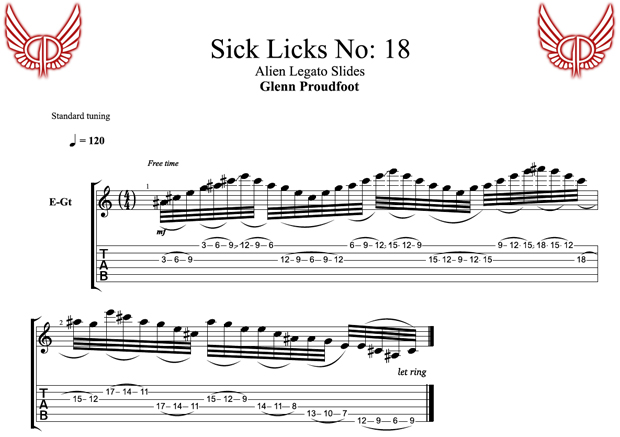Sick Licks: A Little Wide "Alien Legato" Action

This is one of my favorite techniques for moving around on the guitar. It has such an incredible sound and really stands out in your soloing.
It's fantastic to apply this technique to the Diminished 7th scale as it creates greats separation tonally and really throws the listener.
The main challenge with this technique is the stretches. It's very important when practicing this to make sure you have your thumb right behind the neck and you're holding the guitar in a comfortable position to allow maximum finger stretch. Also, be mindful of any discomfort you may feel in your hands or wrist when practicing this. If you are cramping or experiencing pain, stop and practice again after a break.
Your ability to stretch on the guitar, like all techniques, can be worked on, but you must be sure not to push yourself too much in the beginning. You must allow your muscles to get used to this over time. If the stretches are too much for you in the beginning, I suggest moving the pattern up higher on the neck. Once you are comfortable in a higher position, slowly move the pattern back down to the starting position of this lick.
This lick consists of legato and slides; the slides are quick and must be executed fast in order to keep the triplet feel of the lick going.
I start this lick on the third fret of the G string. This legato pattern is three notes per string, so the first group of six notes is with hammers. Then we slide up into the next position, and it's all pull-offs ... then into hammers and so on. Because I'm using the Diminished 7th scale, whatever we play on the G string, we apply the same shape to the high E string.
As this is a repeating pattern, once you have nailed it one position, the rest is easy! I suggest trilling this pattern in one position to get used to it and build some speed before attempting the whole lick.
Get The Pick Newsletter
All the latest guitar news, interviews, lessons, reviews, deals and more, direct to your inbox!
I finish this lick with a run using pull-offs moving down the scale. It can be a little tricky in the beginning because of the stretches and hand movement. When I was practicing this, I found the best way to approach this section was in groups of six, so rather than focusing on the whole run, I would break it down into these groups of six and practice them individually. From there, I would work on putting the whole run together.
The beauty of this lick and technique is that it can be adapted to many styles of music for soloing, anything from jazz to metal.
Practice hard and I hope you enjoy!
Thanks, and I hope you enjoy! Please join me on YouTube here.

Australia's Glenn Proudfoot has played and toured with major signed bands and artists in Europe and Australia, including progressive rockers Prazsky Vyber. Glenn released his first instrumental solo album, Lick Em, in 2010. It is available on iTunes and at glennproudfoot.com. Glenn was featured in the October 2010 issue of Guitar World and now creates "Betcha Can’t Play This" segments and lessons for GW. Glenn also has a monthly GW column, "Loud & Proud," which offers insight into his style and approach to the guitar. Glenn is working on a project with Ezekiel Ox (ex Mammal) and Lucius Borich (Cog), which is managed by Ted Gardner, ex-Tool and Jane's Addiction manager. The band has done pre-production on 22 tracks and is set to hit the studio and finish their first studio album. The album is set for release in 2012. Glenn also is working on the followup to his debut album; it, too, will be released in 2012.










